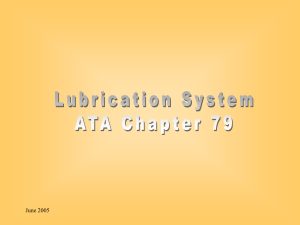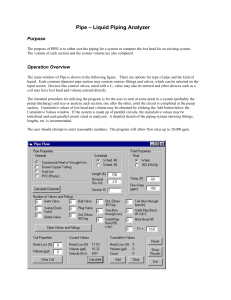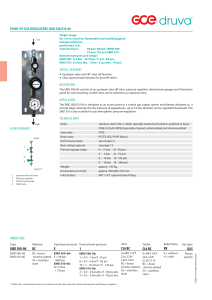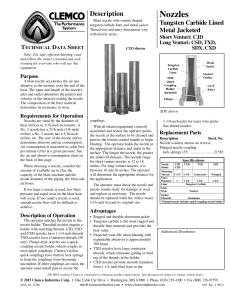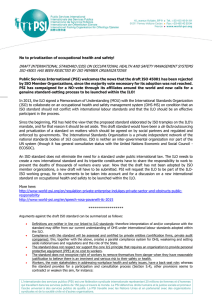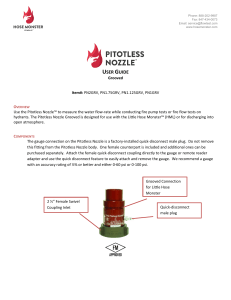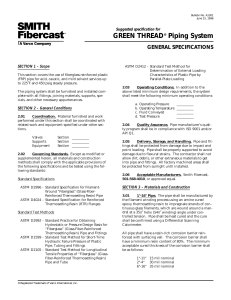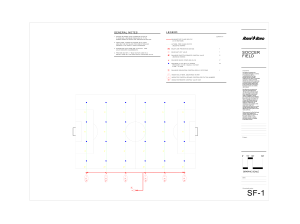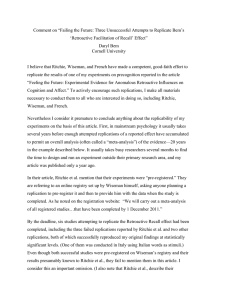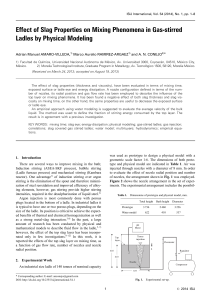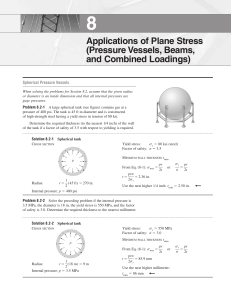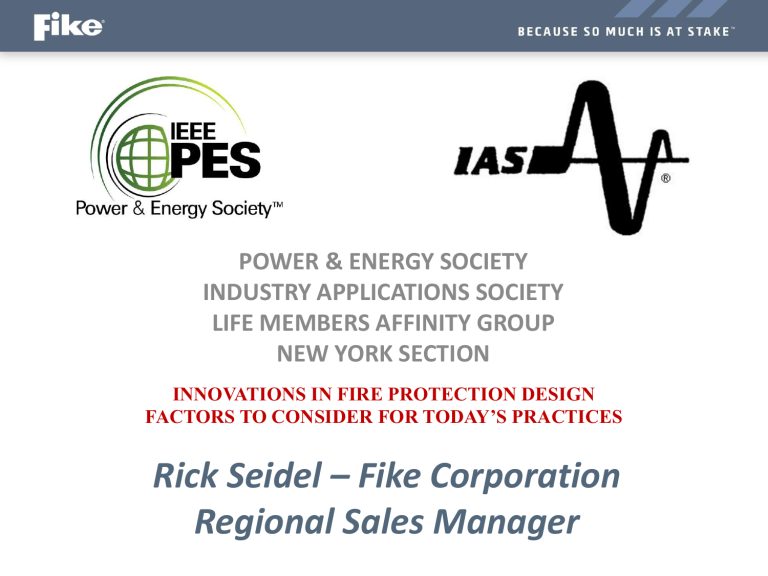
POWER & ENERGY SOCIETY INDUSTRY APPLICATIONS SOCIETY LIFE MEMBERS AFFINITY GROUP NEW YORK SECTION INNOVATIONS IN FIRE PROTECTION DESIGN FACTORS TO CONSIDER FOR TODAY’S PRACTICES Rick Seidel – Fike Corporation Regional Sales Manager Agenda • Inert Gas Fire Suppression – “Clean Extinguishing Agent” – Evolved Enhancements – Advantages • Watermist Fire Suppression Definition of a Clean Extinguishing Agent • As Defined by NFPA 2001, Standard on Clean Agent Fire Extinguishing Systems – Electrically nonconducting, volatile, or gaseous fire extinguishant that does not leave a residue upon evaporation. Clean Extinguishing Agents Mission Critical Protection • • • • • • • Asset Protection Minimizes Downtime Safe for People and Assets Non-Conducting No Residue Space Efficient 3-Dimensional Fire Fighting Back to business…….. Why Not Water? Sprinkler flow time of 30 minutes Each sprinkler discharging 18 to 35 gpm of water That’s 540 to 1,050 gallons of water on your valuable assets! Discharge of two sprinkler heads is common – that’s 1,080 to 2,100 gallons of water!! Fire Extinguishment vs. Fire Control Clean Agent Systems Primary Advantages • Ability to extinguish shielded, obstructed, 3-D fires • Provide rapid extinguishment • Significantly reduces collateral Smoke and water damage caused by delayed extinguishment and Sprinklers – Odorless, Colorless, No residue left behind Clean Agent Fire Protection Halon 1301 Halon 1301 Agent Characteristics . • • • • • • • • Chemical name – Bromotrifluoromethane Vapor Pressure – 235 psi Molecular Weight – 148.9 Boiling Point – -72 F Design Concentration, occupied spaces 5% - 7% Global Warming Potential – 6,290 Ozone Depleting Potential – 16 Safe for Occupied Spaces? YES! Clean Extinguishing Agents Halon 1301….. • Production Ceased in countries that signed the Montreal Protocol in 1994 – Ozone Depletion • No longer sold for new systems • Only sold as recycled / reclaimed agent that is used for recharging systems • Thousands of systems remain in service, with many users actively seeking replacement due to: – Corporate Environmental Initiatives – Long-term Supply Availability – Cost of Replenishment NFPA 2001; Present Day • Commercially available agents – HFC-227ea (FM-200, FE-227) – HFC-125 (FE-25, ECARO-25) – HFC-236fa (FE-36) Most Common Halon 1301 – IG-55 (Argonite, ProInert) Replacements – IG-541 (Inergen) – FK-5-1-12 (Novec 1230, Sapphire) Two Categories of “Clean Agents” Man-Made Agents Naturally Occurring Gases ✔ Zero-Ozone Depleting ✔ LOW- Global Warming Potential (GWP) Waterless Fluids - Flash Gases FM-200® ECARO-25® 1994 2003 – Fluoroketones Novec™1230 2005 ✔ Zero-Ozone Depleting ✔ Zero-Global Warming Potential (GWP) Inert Gases 1st Generation: Inergen® 1994 - 2nd Generation: ProInert2 2009 - Agronite® - 100% Green Fire Protection Inert Agents Argonite® . • Launched in 1994 by Ansul. • Is a mixture of three natural occurring gases: Nitrogen, Argon & Carbon Dioxide. • Environment-friendly, people-safe agent with ZERO ozone depletion potential, ZERO global warming potential, and ZERO atmospheric lifetime. Inert Gases Extinguish a fire by reducing the residual oxygen concentration to a level that will no longer support combustion, but will still sustain human existence. Agent Characteristics . • Chemical name – Mixture of Inert Gases & Carbon Dioxide 52% N2, 40% Ar and 8% CO2 • ASHRAE Designation – IG-541 • Molecular Weight – 34 • Boiling Point – -320.8F • Design Concentration, occupied spaces – 38.5% - 52% • Maximum Human Expose Time – up to 43% is 5 minutes • Maximum Human Expose Time – 43 to 52% is 3 minutes • Ozone Depletion Potential - 0 ProInert2 was launched in to the US market in 2008 by Fike. . Inert systems for Fike make up 90% of their clean agent fire systems sold in Europe. ProInert2 does not use CO2 in its mixture. IG-55 is the same mixture as you will find in Argonite. What Is ProInert? • Inert Gas Fire Extinguishing System – Extinguishes Fires by Oxygen Reduction – Gas stored as a compressed gas/vapor • Extinguishing Gas – IG-55 = 50% Ar / 50% N2 – IG-541 = 50% AR / 40% N2 / 10% CO2 Agent Characteristics . • Chemical name - N2/Ar (50% - 50% blend of Nitrogen & Argon) • ASHRAE Designation – IG-55 • Molecular Weight – 33.95 • Boiling Point – -310.2F • Design Concentration, occupied spaces – 39% - 52% • Maximum Human Expose Time – up to 43% is 5 minutes • Maximum Human Expose Time – 43 to 52% is 3 minutes • Ozone Depletion Potential - 0 ProInert2 - Storage Footprint Traditional Inert Systems: Up to 40% less Reduced Storage Safe for People ProInert is completely safe for use in occupied spaces. P/N: 06-384-1 rev. - What does 12.7% Oxygen Mean to Pikes Peak, Colorado You? - Most visited mountain peak in North America Elevation = 14,110 feet above sea level = 12.2% NFPA and UL minimum allowable design concentration for egress = 10% Inert Agents • Benefits: – Equipment and installation costs close to other clean agents – Similar maintenance costs to other clean agents – Full height walls not an issue – Remote agent storage capability up to 200’ away – Upgrade Any Existing Halon or Clean Agent System Utilizing All Original Piping – Low refill costs Agent Comparisons Man Made Agents (7) Of IG-541 (4) Of PI2 Inert Gas Need: (6) of IG-541 (3) of PI2 (6) of IG-541 (3) of PI2 Complete System Cost Comparison 150 K = Vortex/ Marioff 100K = Fike DQ 150K 68K 47K 45K 43K 39K Agent Comparisons Agent ASHRAE Molecular Weight Global Warming Potential Boiling Point Concentration % Ozone Depletion Halon 1301 n/a 148.9 6290 -72 F 5 – 7% 16 FM-200 HFC-227ea 170.3 3350 2.5 F 6.25 – 10.5% 0 ECARO -25 HFC-125 120.2 3170 -54.7 8 – 11.5% 0 Novec FK-5-1-12 316.04 <1 120.6 F 4.5 – 6% 0 Inergen IG-541 34 0 -320.8 F 38.5 – 52% 0 Argonite IG-55 33.95 0 -310.2 F 39 – 52% 0 Carbon Dioxide CO2 44 1 -109.3F 34% + 0 29 0 -319F “Air” 0 What About Pressure Displacement During An Inert Gas System Discharge? Pressure Venting • Inert Agents displace the oxygen in the room. • Pressure venting is required to avoid overpressurizing the room. • If you forget to do it, the system has a built in method of correcting the problem Fike’s ProInert system is the only system that uses a constant flow rate valve that discharges the agent at a constant low pressure (645 psi / 42 bar) over the required 60 seconds discharge time. Other systems have an aggressive initial discharge, and then decrease flow over time. This can lead to room and equipment damage, and does not extinguish a fire any faster than Fike’s steady flow system. Inert Gas Systems Storage PSI Discharge PSI Pressure Reducer Minimum Nozzle PSI IG-541 Inergen™ 150 Bar 200 Bar 2175 PSI 2900 PSI Orifice Plate 150 Bar 325 PSI 200 Bar 375 PSI IG-55 Argonite™ IG-55 ProInert™ IG-55 ProInert2 200 Bar 200 Bar 300 Bar 2900 PSI 645 PSI 645 PSI Fike Patented Fike Patented Modulating Valve Modulating Valve 116 PSI 116 PSI Orifice Plate 200 Bar 430 PSI An important advantage of ProInert is the lower pressure at discharge, which allows for a controlled flow of gas into the room to extinguish a fire it can also result in lower cost (lower pressure) piping, fewer nozzles, and smaller venting requirements compared to other inert gas systems. Natural Agents Discharge Room Pressure ProINERT2 Room Pressure 1st Generation Natural Agents Room Pressure Pressure (pa) Pressure (pa) 1000.00 900.00 800.00 700.00 600.00 500.00 400.00 300.00 200.00 100.00 0.00 0 10 20 30 40 50 60 70 1000.0 900.0 800.0 700.0 600.0 500.0 400.0 300.0 200.0 100.0 0.0 0 Time (sec) 900-950 Pa=19-20 PSF 10 20 30 40 Time (sec) <400 Pa= 8.35 PSF Wall Strength Specs: 250 Pa (5 PSF) 2x4 walls 16” OC 500 Pa (10 PSF) 2x6 walls 16” OC Venting Requirements 50 60 70 What are the Advantages of the Fike valve? • All piping used in the system from the cylinder to the nozzle is the same as used in chemical systems, Schedule 40 piping and 300 pound fittings • Competition’s inert gas systems require the use of Schedule 160 piping before their required pressure reducing orifice plate and Schedule 80 piping above 2 ½” throughout system. • Competition fittings are 2,000 or 3,000 forged steel before their required pressure reducing orifice plate • Significant savings on installations because of: – Lighter scale piping requirement – Greater flexibility with piping networks configuration and length MAXIMUM ELEVATION DIFFERENCES IN PIPE RUNS The maximum elevation difference between horizontal pipe runs or nozzles is unlimited from the agent supply. Design Factors Maximum Elevation Differences in Pipe Runs = UNLIMITED No limitations apply to the following: a. If nozzles are only located above the cylinder outlet, the maximum elevation difference between the cylinder outlet and the farthest horizontal pipe run or discharge nozzle is unlimited. b. If nozzles are only located below the cylinder outlet, the maximum elevation difference between the cylinder outlet and the farthest horizontal pipe run or discharge nozzle is unlimited. c. If nozzles are located above and below the cylinder outlet, the maximum elevation difference between the (Old Limit = 20.4 ft.) cylinder outlet and the farthest horizontal pipe run or discharge nozzle is unlimited. No Limit No Limit No Limit System with a single level of Nozzles System with multiple levels of Nozzles System with ceiling and sub-floor Nozzles Design Factors Now you can do this . . . 6th Floor 2nd Floor 1st Floor Basement Why Not Water……Mist? Water Mist Overview: What is Water Mist? • Extinguishes fire using a very fine water spray with droplets <1,000µm. • The fine droplets; cools the flame, displaces O² with water vapor and reduces radiant heat. • Designated for use in Class A: Combustible materials (wood, paper, fabric, refuse), Class B: flammable or combustible liquids as the fuel source., and some Class C: electrical hazards; such as transformers (in enclosures). • Class A requires larger droplets to help penetrate fuel source (fuel wetting). • Class B requires finer droplets to avoid agitating fuel surface. • First systems approved, aimed for smallest droplet size, high pressure. • Newer, low pressure systems have obtained FM approvals with larger droplet sizes at much lower pressures. Water Mist Overview: Droplet Size • A larger droplet is more effective at penetrating down into the fire plume (Fuel Wetting) using its momentum (= mass x velocity) • Small droplets do very well in small spaces, smaller the space the better the droplets can be directed to the fire. • The larger the space gets the small droplet now gets difficult to control, it loses velocity as soon as it leaves the nozzle, it then does not know where to go. • Smaller droplets means smaller waterways within the nozzle, now the water quality and impurities become extremely important. Water Mist Overview: Concepts * 3 Main Concepts/Functions: 1. Inerting 2. Cooling 3. Fuel wetting All three are very important. • Inerting = Oxygen Displacement • Cooling = Heat Extraction • Fuel wetting = Blocking of Radiant Heat, preventing the fire from propagating. • Droplet size impacts the relative presence of each effect * Different Fires require different amounts of each element! Water Mist Overview: Droplet Size Smaller Droplet: More efficient vaporization, cooling and inerting. 10 µm 100 µm Water Mist Nozzle SWEET ! Larger Droplet: More efficient fuel wetting. Storage applications. Where’s the sweet spot? 300 µm 400 µm 300 µm gives the droplet the best of both efficient vaporization and fuel wetting. 1,000 µm Sprinkler Heads Water Mist Overview: Benefits • As the water mist turns to steam, it expands immensely (1700 times) forcing oxygen away from the flame. • Takes the energy out of the fire. • Water mist incorporates a smoke scrubbing element. • Provides extinguishment, not control. • Provides 3D fire protection. • Only need about 6-8 psi bar inlet pump pressure (wet pipe system), this is an estimate as the amount is determined by the Net Positive Suction Head Required (NPSHR) for the pumps plus our manual’s safety margin of 2 psi. (Deluge system needs 29psi to keep the valve shut). • Uses up to 80% less water than sprinklers (deluge app), and 50% less water than sprinklers (Light Hazard app). Water Mist Overview: System Types Low Pressure High Pressure • • A water mist system where the distribution system piping is exposed to pressures of 500psi or greater and up to 2000psi. Uses ultra-high pressure pipe, fittings, & valves. • • Continuous Supply Fixed Supply • • • Driven through system by N2 pressure Must be refilled after discharge System cannot fight against any possible reignition of fire. A water mist system where the distribution piping is exposed to pressures 175psi or less. Uses standard pipe, such as Sch 40 SS, plus Class 150 300psi fittings. • • • Uses building water supply Driven by pump Unlimited discharge time Water Mist Overview: System Design • No universal design method is recognized for water mist protection systems. • Fike’s design is different from others. • Design & install in accordance with each manufacturer’s Design, Installation, Operation, and Maintenance Manual (DIOM), requirements of FM Global (where applicable), NFPA Standards (750), and the requirements of the AHJ. DuraQuench™ Benefits: Simplicity vs: Versatile, Affordable Water Mist Fire Suppression ● LOWER OPERATING PRESSURE 175 psi versus 2000 psi ● MORE PIPE & FITTING OPTIONS Easily sourced pipe, fittings, and tools Stainless steel, copper, CPVC ● SIMPLE LAYOUT & DESIGN Use any hydraulic flow-calc software ● STANDARD FIKE LEAD TIMES Made from readily available components ● FM APPROVED, NFPA-750 COMPLIANT ● WATER Only need 6-8 psi inlet pump pressure 50-80% less water than sprinkler Pump Controller DuraQuench™ Benefits: Largest Machinery Space & Turbine Enclosure Approved Volume Company Maximum Approved Room Volume Max Ceiling Height Fike - DuraQuench™ 162,801 ft3 39.4 ft Marioff – HI-FOG GPU 53,000 ft3 32.8 ft 48,600 ft3 36.1 ft Tyco - AquaMist® 45,203 ft3 26 ft. 3 in FOGTEC Water Mist System 9,535 ft3 Not available HI-FOG MT4 Water Mist System 48,600 ft3 36.1 ft Securiplex - FIRE-SCOPE® 5000 42,380 ft3 Not FM Approved for insulated turbines. HI-FOG MT4 Water Mist System TomCO2 Fogex® System 17,657 ft3 36 ft Not available Deluge Systems in Industrial Applications Wet Pipe Systems Commercial Applications DuraQuench™ Deluge: System Info • Utilizes Open Nozzles. Total Flood. • Piping network is empty (open to atmosphere) from the system deluge valve to the nozzles during normal system operation. • Water supply is held back by the deluge valve. • Deluge valve is opened automatically through the activation of the solenoid installed on the valve trim in response to the activation of the fire detection system installed in the protected area. • Simultaneously, the detection system activates the fire pump sending pressurized water through the piping network to the open nozzles. • ONLY Stainless steel Sch 10 and/or Sch 40 pipe can be used along with Class 150 (300psi) threaded fittings. DuraQuench™ Deluge: Zoned System DuraQuench™ Deluge: C-EL Control Valve 2” = 46 lbs.(20.8 kg) 3” = 74 lbs. (33.6 kg) Weight • Used as a full flooding deluge valve or as a zone valve. • 29 psi needed to keep closed. Working Pressure 232 psi maximum 29 psi minimum Factory Tested Pressure 348 psi maximum Materials Stainless Steel, ANSI 316L Gasket Materials EPDM Pressure Gauge Locations Valve Inlet and Primary Valve Outlet Activation Options − − Manual Release Lever Electric Impulse Solenoid (24 VDC, 10W, NC) Listing / Approvals Factory Mutual DuraQuench™ Deluge: Open Nozzle • Open head nozzle • 4.1 GPM per nozzle at minimum pressure. • Tested by FM for hazard volumes up to 28,252ft3 and 162,801ft3 – Nozzle spacing and ceiling height varies according to enclosure volume approval. • K Factor = 0.387 g/min/√psi (5.6 L/min/bar) FM Approved Volume (max.) 28,252 ft3 162,801 ft3 Ceiling Height (max.) 26.2 ft 39.4 ft Nozzle Spacing (max.) 117.3 ft2 10.8 ft x 10.8 ft 96.8 ft2 9.8 ft x 9.8 ft Distance to wall (max.) 5.4 ft 4.9 ft Water Density 0.055 0.067 Specifications Minimum water pressure 112 psi (8 bar) Maximum water pressure 232 psi (16 bar) K-Factor 0.387 gal/min/√psi Drop size DV90 < 300 µm Material Brass (NiSn Coated) Stainless Steel 316L DuraQuench™ Industrial Applications: General Machinery Space Protection • Diesel generators / Turbines • CNC areas • Gear boxes • Drive shafts • Bearings • Lube skids • Transformer rooms DuraQuench™ Industrial Applications: Automotive - Test Cell Protection (Example Layout) DuraQuench™ Wet Pipe: System Info • Utilizes Closed Head automatic nozzles. • Operates just like a traditional sprinkler system. • Wet Pipe network is filled with water to the nozzles during normal system operation. • Thermal element designed to open the nozzle when the temperature surrounding the nozzle reaches 135°F. • Must be installed in areas where the temperature is reliably maintained above 40°F so that pipes do not freeze. • Optional pressure maintenance (jockey) pump. DuraQuench™ Wet Pipe: Applications – Light Hazard (HC-1) Hazard • • • Non-Storage Occupancies, Hazard Category 1 Lightly loaded non-storage, non-manufacturing areas Examples: Apartments, churches, concealed spaces, hospitals, hotels, kitchens, libraries, museums, nursing homes, offices, restaurants, schools, un-used heated attics Design Considerations • • • Closed head nozzles with glass bulb rated for 135◦F (Fike). Wet Alarm system, water is present in pipe at all times. Designed to provide water (FM) for 60 minutes to the nine most hydraulically remote nozzles or all nozzles in 1500 ft2 space, whichever is greater. FM Approvals • • Unlimited area Approved pipe: Stainless, Copper, & CPVC. DuraQuench™ Wet Pipe: Closed Nozzles • Closed head nozzle works just like a traditional sprinkler head. • 12.50 GPM per nozzle at minimum pressure, 50% less water than a traditional sprinkler head (1/2” 5.6k sprinkler at 25-30gpm). • Chrome or white cover plate, plus custom color options. • K-Factor 1.16 g/min/√psi Nozzle Spacing Specifications Ceiling Height (max.) 16.4 ft Nozzle Spacing (max.) 14.8 ft x 14.8 ft Distance to wall (max.) 7.4 ft Specifications Minimum water pressure 116 psi Maximum water pressure 232 psi K-Factor 1.16 g/min/√psi Drop size DV90 < 300 µm Material Brass (NiSn Coated) Nominal Release Temp 135⁰F DuraQuench™: “Accepted” or “Performance Based Design” Applications • FM has testing protocols for applications that Fike hasn’t pursued…yet. So these, by definition, are outside of our current approvals. • However, we can get the design “Accepted” by the Local AHJ based on the design and fire testing that has been completed. • Fike can provide you with fire testing documents and design information on most applications. DuraQuench™ Accepted Design: Application - Pre-Action Protection • Protection of Data Centers with pre-action valves & closed nozzles. • We already have a Pre-Action valve so an “Accepted” system can be designed. • Data Center FM Approvals coming in Q4 2018: – Above Floor Protection – Below Floor Protection – Area of Coverage Design – Below Floor Protection – Local Application Design DuraQuench™ Accepted Design: Application - Industrial Fryer Protection • Can provide an Industrial Oil Cooker Nozzle that is FM Approved, use that with DuraQuench™’s FM Approved system components for easy acceptance by AHJ. • DuraQuench™ installed protecting 7 industrial oil cookers at a peanut facility in North Carolina. AHJ accepted system after conference call and live system demonstration at the peanut facility. In Closing….. - Most Environmentally Friendly Clean Agent - Now can use 40 - 50% less cylinders - Controlled Discharge to minimize violence - Low Pressure & Easy to Flow - Unlimited & CLEAN Water Supply - Easily sourced and lower cost hardware and installation In Closing….. Fike Fire Protection Solutions Systems • Fire alarm • Fire detection and control • Intelligent alarm • Video image • Early warning detection • Fire suppression Suppression • Clean agent • CO2 • Water based Thank You! Questions?
